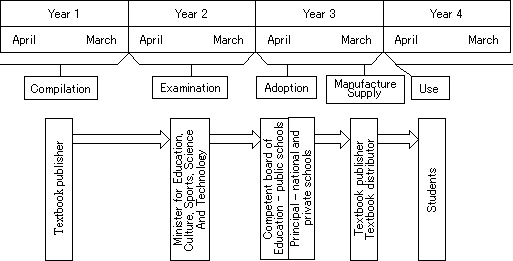How a Textbook Becomes Part of a School Curriculum
(provisional translation)
Before a textbook is introduced as a part of a school curriculum, it must go through several steps, including government examination and adoption after being compiled by textbook publishers. The overall process is described below (see Figure 1 and Table 1).
1. Compilation
The current school textbook system is based on authoring and compilation of textbooks by private-sector publishers. Publishers compile the textbooks they issue based on the Courses of Study, Textbook Examination Standards, etc., as well as incorporating their own creativity and ingenuity. Once textbooks are completed, publishers apply for government examination.
2. Examination
Only those textbooks that have passed an examination conducted by the Minister of Education, Culture, Sports, Science and Technology (hereinafter referred to as "the Minister") may be used in school curriculums. After a publisher of a textbook applies for examination, the textbook concerned will be studied by textbook experts of the Ministry of Education, Culture, Sports, Science and Technology (MEXT). It will also be referred to the Textbook Approval and Research Council, which is an advisory body to the Minister. The Minister will examine the textbook concerned based on the findings of the report submitted by the Council. The textbook examination standards form the basis by which textbooks are screened to determine their suitability for inclusion in school curriculums.
3. Adoption
In most cases, more than one approved textbook is available for each category (subject-based textbook classification unit, e.g. "Elementary School Japanese Language (1st through 6th grade)", "Junior High School Social Studies (geography-related)" or "Senior High School Mathematics I"). As such, each Board of Education must make a decision as to which textbook will be used for the schools. In the case of public schools (excluding national schools), authority to select and adopt textbooks rests with the competent Board of Education at the local level. In the case of national and private schools, it is the principal who is authorized to select the textbook to be used at those schools. A report outlining the requisite number of textbooks adopted is submitted to the Minister.
4. Publishing (Printing and Distribution) and Use
Based on the information submitted in the reports on the requisite number of textbooks, the Minister issues instructions to the publishers indicating which textbooks to be published and how many.
Based on said instructions, publishers produce textbooks and supply them to schools through distributors. Students receive the textbooks from their schools.
5. Free Supply of Textbooks
The Government of Japan bears the cost of textbooks for all students at national, public and private compulsory-level schools (elementary schools, junior high schools, first three years of integrated high schools, and elementary and junior high divisions of schools for the blind, the deaf and the disabled).
Figure 1
How a Textbook Becomes Part of a School Curriculum

Note: The periods indicated above for the date of publishing, supply and use of textbooks are applicable for textbooks to be used in the first semester.
Table 1
Examination and Adoption Cycles for Elementary, Junior High and Senior High School Textbooks
| School Year | 10 (1998) |
11 (1999) |
12 (2000) |
13 (2001) |
14 (2002) |
15 (2003) |
16 (2004) |
17 (2005) |
18 (2006) |
||
|---|---|---|---|---|---|---|---|---|---|---|---|
| Classification | |||||||||||
| Elementary school | Examination | ||||||||||
| Adoption | |||||||||||
| Start of use | |||||||||||
| Junior high school | Examination | ||||||||||
| Adoption | |||||||||||
| Start of use | |||||||||||
| Senior high school | Mainly Junior year | Examination | |||||||||
| Adoption | |||||||||||
| Start of use | |||||||||||
| Mainly intermediate year | Examination | ||||||||||
| Adoption | |||||||||||
| Start of use | |||||||||||
| Mainly senior year | Examination | ||||||||||
| Adoption | |||||||||||
| Start of use | |||||||||||
Notes:
- Entries made in the field to the right of each set of bold lines apply to textbooks subject to the new Courses of Study.
- Elementary School Courses of Study (a 1998 notification of the Ministry of Education) - to be fully introduced to the 2002 school year
- Junior High School Courses of Study (a 1998 notification of the Ministry of Education) - to be fully introduced to the 2002 school year
- Senior High School Courses of Study (a 1999 notification of the Ministry of Education) - to be phased in from the 2003 school year with the yearly progression of the student class entering high school that year
- Junior high schools include the first three years of integrated high schools, while senior high schools include the last three years of integrated high schools.
Back to Index
